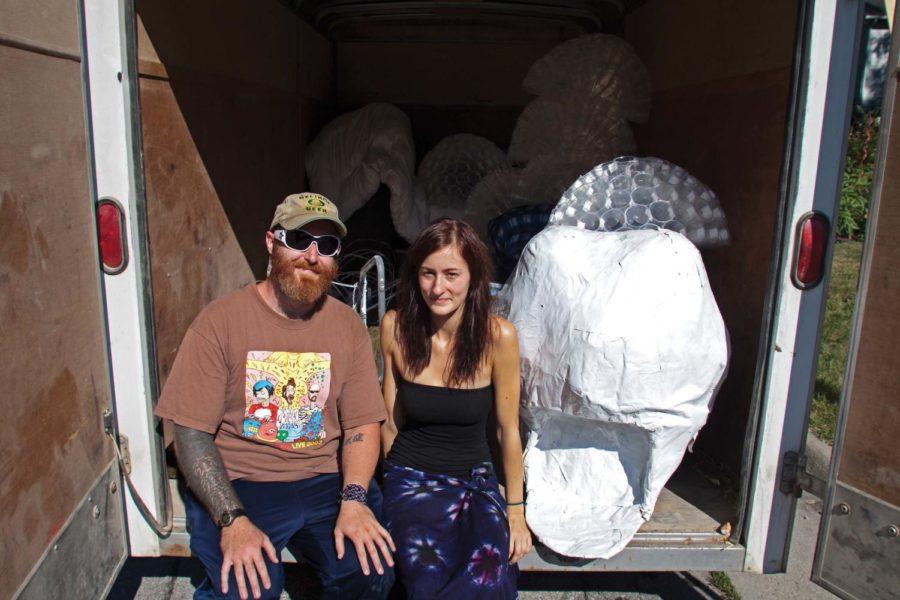At Burning Man, students and their professor enjoy freedom amid the flames
Photo: Cristobal Matibag/Iowa St
Lyndsey Batz, junior in political science, and Jay Parry, senior in English, pack a trailer in preparation to leave for their trip to Burning Man 2011 on Friday at Parry’s home. Burning Man is a weeklong annual art festival that takes place in Nevada’s Black Rock Desert.
August 28, 2011
Eight ISU students spent summer 2011 creating original works of art. This week, on a dry lakebed in the Nevada desert, they will set them on fire.
The students will be among thousands of artists torching their creations at Burning Man, an annual, weeklong festival where a city is created, inhabited for a week and then dismantled.
The works that are set to burn were made for a class called Burning Man Studio. [corrected from: Shifting Sands: Transient Architecture in the Desert.]
Devised and taught by Samantha Krukowski, adjunct assistant professor of architecture, the class guides students as they develop projects for Burning Man and prepares them for the rigors of a week in the desert.
The festival is named for a giant wooden effigy — known to attendees as “The Man” — that organizers erect and burn during its second-to-last day.
Jay Parry, senior in English, will be burning a “man” of his own at the festival, albeit a far smaller one. His paper-mache and wire sculpture, which he calls “ten Brink,” depicts a man who has torn one eye out of its socket and is holding it to face him.
“He has to use his own optic nerve to get a look at himself,” Parry said of the work.
After the sculpture’s outer layer burns, Parry will use its wire frame as the “skeleton” for a new sculpture — one made wholly from materials he gathers at the festival.
Lyndsey Batz, junior in political science, made an updated version of the Native American dreamcatcher for the festival. Instead of the traditional wood and thread, hers is rendered in silicone and steel. The piece, called “GABA,” is named for a neurotransmitter that induces sleep. To make it, Batz took motherboards from camcorders and other devices and affixed them to metal plates.
Because the materials used for her piece were scavenged rather than bought, she considers it a response to the “commercialized” traditional dreamcatcher.
The course in which Batz and Parry prepared their works is a recent addition to the ISU catalog, having only been offered since 2010. So far, it’s the only course in the world that specifically incorporates a trip to Burning Man.
Krukowski thinks her students’ experience at the festival will teach a lesson that’s not always stressed in the design curriculum: the transience of material things.
“Most often people are — especially in architecture — designing things to be permanent. But the things that are built for Burning Man either get taken out or burned,” she said.
When they’re not burning their art, or watching “The Man” go up in flames, the students will be able to enjoy food, music and rides on heavily modified cars and trucks known as “mutant vehicles.” Festival guidelines dictate that all these experiences and the goods that come with them be given as gifts.
“You can’t buy or sell anything there. And people will just set up a hot dog stand, or a bar or an ice cream counter,” Krukowski said. “You might just be walking along in the desert and all of a sudden this 100-foot yacht on wheels starts passing you by. And you just jump on.”
Along with the fun, the festival hosts more serious rituals. On its final day, organizers burn a large temple. Before it’s incinerated, festivalgoers cover it with messages and fill it with symbolically significant objects. This year, Krukowski will have something to add.
“I had to euthanize a dog a couple of years ago, and I’ve had his ashes since then,” she said. “He’s going to the temple. So he’s going to have his second burn.”
Krukowski was reluctant to discuss her other plans for the event, saying she would see what happened when she got to it.
“Part of the fun of Burning Man is just finding your way through and trying to see what’s out there.”







